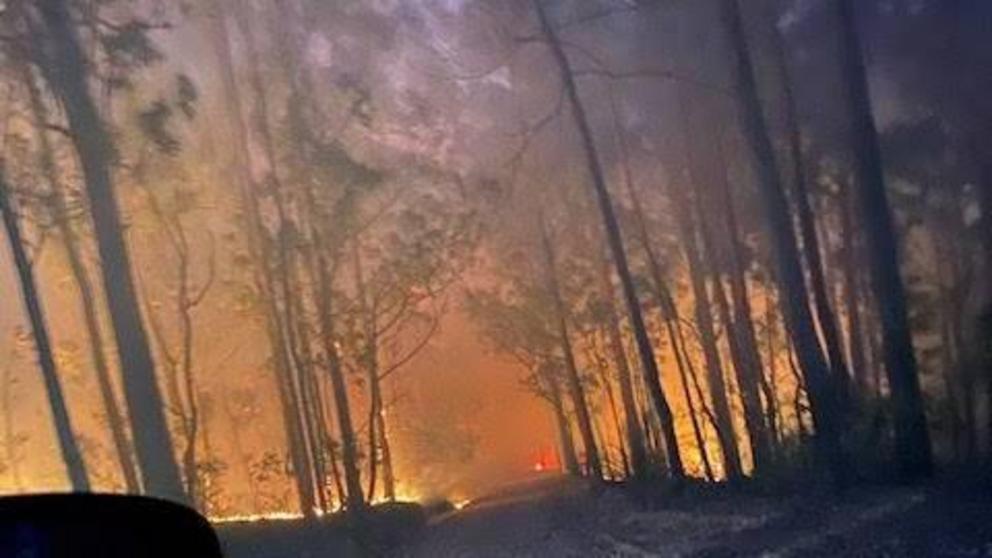Australia fires: heavy rain and cooler temperatures 'unlikely' to end bushfire threat
More than a hundred fires are still burning across Australia, with flare-ups on Kangaroo Island leaving residents without power.
Flare-ups have recurred on Kangaroo Island, despite rainfall, and forecast showers for NSW are unlikely to end the threat.
Heavy rains forecast for this week are unlikely to end Australia’s long-running bushfire threat, despite pockets expected in bushfire-affected areas.
Rain was forecast for parts of the central and northern coasts on Monday, and thunderstorms and showers forecast for most of NSW on Thursday, when up to 25mm is expected to fall on parts of the South Coast.
The RFS early on Monday tweeted that if the rainfall forecast “comes to fruition then this will be all of our Christmas, birthday, engagement, anniversary, wedding and graduation presents rolled into one”, but NSW Rural Fire Service spokesperson Anthony Bradstreet told Guardian Australia the rainfalls are unlikely to be heavy enough to put out fires across the state.
“With the period of drought we’ve experienced, we’d need to get extended periods of consistent rainfall in order to get the moisture content up enough for it to put out fires … which is unlikely,” said Bradstreet.
The RFS said there were more than 100 fires still burning across the state and many would take some time to fully contain, with 36 fires still burning out of control.
The Gospers Mountain fire which has burned for two-and-a-half months northwest of Sydney was finally brought under control on Sunday.
“After lightning started the fire on October 26, it has burnt through more than 512,000 hectares across the Lithgow, Hawkesbury, Hunter Valley, Cudgegong, Blue Mountains and Central Coast local government areas,” the Hawkesbury RFS said on Facebook.
The NSW RFS has now turned its attention to the out of control fires burning in the Snowy Valley region where 337,000 hectares of land has burned.
Air quality across much of the state, including Sydney, was very poor on Monday as a result of smoke from the bushfires. Hazardous air quality was also recorded in parts of Sydney’s northwest, southwest, the Illawarra, Albury and Wagga Wagga.
In Victoria the Cann Road bridge fire flared up in the state’s far east on Monday afternoon with an emergency warning issued for Noorinbee and Noorinbee North, near the NSW border. The alert came as cooler weather reduced the threat to communities elsewhere in the state.
“These fires aren’t out and they’re not going to be out until they burn themselves out or we finish with a really big rain event,” Victoria’s premier Daniel Andrews told KIIS FM on Monday.
“The weather bureau’s not telling us that’s likely.”
There are 19 active fires across Victoria, more than 1.3m hectares have been burned and 1,500 firefighters remain on the job.
Meanwhile, people stranded in the Victorian town of Mallacoota have been evacuated by Australian defence forces in armoured vehicles.
Chief of Joint Operations Lt Gen Greg Bilton said armoured vehicles were used to protect people from falling trees.
“The routes are by no means open,” Bilton said on Monday, but defence was working to open the Princes Highway and other roads in the state’s Gippsland region.
“It’s important to stress that it’s still unsafe to just freely move along those routes.”
Residents and holiday-makers in Mallacoota have been cut off from the rest of Victoria by the recent bushfires.
While the bulk have been rescued by sea, defence forces had used the armoured vehicles to get people back to Melbourne by road.
Bilton said 100 engineers from the Papua New Guinea Defence Force would arrive in the state on Monday to help firefighters with road clearing.
“We’re deeply grateful ... they are going to play a key role throughout East Gippsland,” Bilton said.
Singaporean defence personnel were also helping get supplies to isolated Gippsland communities by air.
In South Australia, flare-ups across the Kangaroo Island fireground were hampering efforts to restore full power to island residents.
More than 600 properties remained without electricity on Monday but SA Power Networks said it was reassessing the damage to equipment following renewed fire activity in some areas.
The work on Monday was focused on the island’s north as access to the southern fire zone remains restricted, the company said.
The Kangaroo Island fire has burned more than 210,000 hectares inside a 500km perimeter.
Twenty-eight people have died in bushfire-related incidents in Australia since October.
Fires have also destroyed 2,136 homes in NSW – more than 1,200 of which have burned down since New Year’s Eve – while hundreds of properties and structures have been lost in Victoria.
In South Australia, more than 50 homes have been confirmed lost, along with several hundred other buildings, although a full damage assessment is yet to be completed following the major escalation in the fire emergency late last week.
For the rest of this article please go to source link below.

